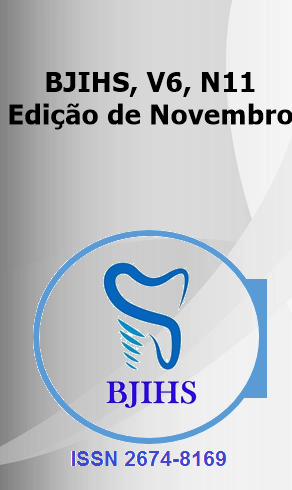Abstract
The use of orthodontic appliances can contribute to a greater accumulation of dental biofilms, by providing new retentive areas, leading to the appearance of white spots adjacent to the brackets. Several models of brackets have been developed with the aim of minimizing microbial accumulation, such as self-ligating brackets, as they do not require elastomeric ligatures. Scardovia wiggsiae was recently described as a bacterium associated with early childhood caries and white spots. The objectives of the present study were to detect and compare the presence of Scardovia wiggsiae in biofilms collected adjacent to self-ligating and conventional metal brackets in volunteers using the device for more than 6 months. Twenty-six volunteers were included, 10 with conventional metal brackets and 16 with self-ligating brackets. The patients were examined orally for the detection of white spots and then biofilm samples were collected from tooth 41. This material was sent for DNA extraction and then submitted to real-time PCR with specific primers for S. wiggsiae. S. wiggisiae was detected in 26.9% of the samples, 35.7% of which had white spots. There were no statistically significant differences between the detection of bacteria and the type of bracket or regarding white spot detection (p>0.05). White spots were more frequently detected in patients with self-ligation (p<0.05). In conclusion, S. wiggisiae was found in a minority of the samples, not being associated with the presence of stains or the type of bracket.
References
BAKA, Z.M. et al.,Effects of 2 bracket and ligation types on plaque retention: A quantitative microbiologic analysis with real-time polymerase chain reaction. American Journal of Orthodontic and Dentofacial Orthopedics, St. Louis, v.144, n. 2, p. 260-267, ago. 2013.
CHEN, Yi‐Wen; WU, Guan‐Hua; LEE, Bor‐Shiunn; LIU, Chung‐Te; LI, Huei‐Ying; CHENG, Shih‐Jung; KUO, Wei‐Ting; JENG, Jiiang‐Huei; CHANG, Po‐Chun; LIN, Chun‐Pin. Third‐generation sequencing‐selected Scardovia wiggsiae promotes periodontitis progression in mice. Journal Of Periodontal Research, [S.L.], v. 58, n. 1, p. 155-164, 30 nov. 2022
Damé-Teixeira, Naile, et al. “Perfil de expressão gênica de Scardovia Spp. no metatranscriptoma da cárie radicular”. Pesquisa Oral Brasileira , vol. 34, maio de 2020, p. e042. SciELO , https://doi.org/10.1590/1807-3107bor-2020.vol34.0042.
DAVIS, S.M. et al.,Consequences of orthodontic treatment of periodontal health: clinical and microbial effects. Semin Orthodontics, v.20, p.139-149, 2014.
DO NASCIMENTO, L. E. et al.,Are self-ligating brackets related to less formation of Streptococcus mutans colonies? A systematic review. Dental Press Journal Orthodontics, v. 19, n. 1, p. 60-8, Jan-Feb 2014.
FORSBERG, C. M. et al.,Ligature wires and elastomeric rings: two methods of ligation, and their association with microbial colonization of Streptococcus mutans and lactobacilli. Europe Journal Orthodontics, v. 13, n. 5, p. 416-20, Oct 1991.
KRESSIRER, Christine A.; SMITH, Daniel J.; KING, William F.; DOBECK, Justine M.; STARR, Jacqueline R.; TANNER, Anne C.R.. Scardovia wiggsiae and its potential role as a caries pathogen. Journal Of Oral Biosciences, [S.L.], v. 59, n. 3, p. 135-141, ago. 2017.
MARCOS, Ângela Maisa da Silva; BARBOSA, Emilly Camilly de Aguiar; PAES, Gabriela da Silva; SILVA, Jéssika Vitória Lima da; ALBUQUERQUE, Maria Eduarda de Moura Silva; ALCÂNTARA, Ana Clara Feijó de; PAZ JÚNIOR, Francisco Braga da; FREITAS, Lindeberg Rocha; GUARANÁ, Carlos Fernando Rodrigues; PAZ, Eliana Santos Lyra da. Estudo comparativo da influência de aparelhos ortodônticos fixos e móveis na microbiota bucal. Research, Society And Development, [S.L.], v. 12, n. 1, p. e11312139448-e11312139448, 4 jan. 2023.
MCDANIEL, Steven; MCDANIEL, Jaydene; HOWARD, Katherine M.; KINGSLEY, Karl. Molecular Screening and Analysis Reveal Novel Oral Site-Specific Locations for the Cariogenic Pathogen Scardovia wiggsiae. Dentistry Journal, [S.L.], v. 9, n. 6, p. 73, 17 jun. 2021.
PELLEGRINI, P. et al.,Plaque retention by self-ligating vs elastomeric orthodontic brackets: quantitative comparison of oral bacteria and detection with adenosine triphosphate-driven bioluminescence. American Journal of Orthodontics and Dentofacial Orthopedics, v. 135, n. 4, p. 426 e1-9; discussion 426-7, Apr 2009.
PELLEGRINI P. et al.,Plaque retention by self-ligation vs elastomeric orthodontic brackets: quantitative comparison or oral bacteria detection with adenosine triphosphate-driven bioluminescence. American Journal of Orthodontics and Dentofacial Orthopedics; v.135, n. 4, p.426.e1-9, 2009.
PEREZ-CHAPARRO, P. J. et al.,Newly identified pathogens associated with periodontitis: a systematic review. Journal Dentistry Review, v. 93, n. 9, p. 846-58, Sep 2014.
SIFAKAKIS, Iosif; PAPAIOANNOU, William; PAPADIMITRIOU, Aikaterini; KLOUKOS, Dimitrios; PAPAGEORGIOU, Spyridon N.; ELIADES, Theodore. Salivary levels of cariogenic bacterial species during orthodontic treatment with thermoplastic aligners or fixed appliances: a prospective cohort study. Progress In Orthodontics, [S.L.], v. 19, n. 1, p. 16-25, 1 ago. 2018.
SWARTZ ML et al.,Ceramic Brackets. Joumal of Clinical Orthodontics, v. 28, n.01, Marc 1988.
TANNER, A. C. et al.,White-spot lesions and gingivitis microbiotas in orthodontic patients.Journal Dentistry Reiwes, v. 91, n. 9, p. 853-8, Sep 2012.
TANNER, A. C. R.; MATHNEY, J. M. J.; KENT, R. L.; CHALMERS, N. I.; HUGHES, C. V.; LOO, C. Y.; PRADHAN, N.; KANASI, E.; HWANG, J.; DAHLAN, M. A.. Cultivable Anaerobic Microbiota of Severe Early Childhood Caries. Journal Of Clinical Microbiology, [S.L.], v. 49, n. 4, p. 1464-1474, abr. 2011.
TANNER, A.C.R.; KRESSIRER, C.A.; ROTHMILLER, S.; JOHANSSON, I.; CHALMERS, N.I.. The Caries Microbiome: implications for reversing dysbiosis. Advances In Dental Research, [S.L.], v. 29, n. 1, p. 78-85, 22 jan. 2018.
TORLAKOVIC, Lino; KLEPAC-CERAJ, Vanja; ØGAARD, Bjørn; COTTON, Sean L.; PASTER, Bruce J.; OLSEN, Ingar. Microbial community succession on developing lesions on human enamel. Journal Of Oral Microbiology, [S.L.], v. 4, n. 1, p. 1-7, jan. 2012.
VANISHREE, T. et al.,Changes in the Oral Environment after Placement of Fixed Orthodontic Appliance for the Treatment of Malocclusion - a Descriptive Longitudinal Study. Oral Health Dent, v. 15, n. 5, p. 453-459, 2017.
WALSH, Lj; HEALEY, Dl. Prevention and caries risk management in teenage and orthodontic patients. Australian Dental Journal, [S.L.], v. 64, n. 1, p. 37-45, 30 maio 2019.

This work is licensed under a Creative Commons Attribution 4.0 International License.
Copyright (c) 2024 Letícia Gonçalves Rezende, Flavia Ana Pacheco, Gabrielle Luiza de Camargos Pessoa, Caroline Viel de Souza Copati, Francielle Kerolayne Vieira da Silva, Giovanna Schroden Rodrigues da Cunha , Helena Nery Jardim, Luisa Ávila Paiva, Lara Teixeira Junqueira Freire, Vinicius Rangel Geraldo Martins, Ruchele Dias Nogueira Geraldo Martins
